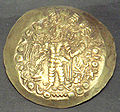Kushano-Sasanian Kingdom
Kushano-Sasanian Kingdom Kushanshahr | |||||||||||||
|---|---|---|---|---|---|---|---|---|---|---|---|---|---|
| c. 230 CE–c. 365 CE | |||||||||||||
Feudal monarchy | |||||||||||||
| Kushanshah | |||||||||||||
• 233-245 | Ardashir I Kushanshah | ||||||||||||
• 330-365 | Varahran Kushanshah | ||||||||||||
| Historical era | Late Antiquity | ||||||||||||
• Established | 230 CE c. 230 CE | ||||||||||||
• Disestablished | c. 365 CE | ||||||||||||
| |||||||||||||
| Today part of | Pakistan Afghanistan Turkmenistan | ||||||||||||
The Kushano-Sasanian Kingdom (or Indo-Sasanians) was a polity established by the Sasanian Empire in Bactria during the 3rd and 4th centuries. The Sasanian Empire captured the provinces of Sogdia, Bactria and Gandhara from the declining Kushan Empire following a series of wars in 225 CE.[1] The local Sasanian governors then went on to take the title of Kushanshah (KΟÞANΟ ÞAΟ or Koshano Shao in the Bactrian language[2]) or "King of the Kushans", and to mint coins.[1] They are sometimes considered as forming a "sub-kingdom" inside the Sasanian Empire.[3]
This administration continued until 360–370,[1] when the Kushano-Sasanians lost much of their domains to the invading Kidarites; the remainder was incorporated into the Sasanian Empire proper.[4] Later, the Kidarites were in turn displaced by the Hephthalites.[5]
The Kushanshahs are mainly known through their coins. Their coins were minted at Kabul, Balkh, Herat, and Merv, attesting the extent of their realm.[6]
A rebellion of Hormizd I Kushanshah (277–286 CE), who issued coins with the title Kushan-shahanshah ("King of kings of the Kushans"), seems to have occurred against contemporary emperor Bahram II (276–293 CE) of the Sasanian Empire, but failed.[1]
History

The Sassanids, shortly after victory over the
The Kushano-Sasanians under
Around 325,
The decline of the Kushans and their defeat by the Kushano-Sasanians and the Sasanians, was followed by the rise of the
Religious influences
Coins depicting Shiva and Nandi have been discovered, indicating a strong influence of Shaivism. [citation needed]
The prophet
On that occasion, various Buddhist influences seem to have permeated Manichaeism: "Buddhist influences were significant in the formation of Mani's religious thought. The transmigration of souls became a Manichaean belief, and the quadripartite structure of the Manichaean community, divided between male and female monks (the 'elect') and lay follower (the 'hearers') who supported them, appears to be based on that of the Buddhist sangha".[9]
Coinage
The Kushano-Sassanids created an extensive coinage with legend in
The obverse of the coin usually depicts the ruler with elaborate headdress and on the reverse either a fire temple or Shiva with Nandi.
-
Kushano-Sasanian ruler Ardashir I Kushanshah, circa 230-250 CE. Merv mint.
-
Indo-Sassanid coin.
-
A gold Indo-Sassanid coin.
Kushano-Sasanian art
The Indo-Sassanids traded goods such as silverware and textiles depicting the Sassanid emperors engaged in hunting or administering justice.
-
Kushano-Sasanian footed cup with medallion, 3rd-4th century CE, Bactria, Metropolitan Museum of Art.[11]
-
Possible Kushano-Sasanian plate, excavated in Rawalpindi, Pakistan, 350-400 CE.[12] British Museum 124093.[13][14]
-
Terracotta head of a male figure, Kushano-Sasanian period, Gandhara region, 4th-5th century CE
Artistic influences
The example of Sassanid art was influential on Kushan art, and this influence remained active for several centuries in the northwest South Asia. Plates seemingly belonging to the art of the Kushano-Sasanians have also been found in Northern Wei tombs in China, such as a plate depicting a boar hunt found in the 504 CE tomb of Feng Hetu.[15]
Main Kushano-Sassanid rulers
The following Kushanshahs were:[21]
- Ardashir I Kushanshah (230–245)
- Peroz I Kushanshah (245–275)
- Hormizd I Kushanshah (275–300)
- Hormizd II Kushanshah (300–303)
- Peroz II Kushanshah (303–330)
- Varahran Kushanshah (330–365)
See also
| History of Afghanistan | |
|---|---|
 The palace of the emir in 1839 | |
| Timeline | |
| 410–557 | |
| Nezak Huns | 484–711 |
History of South Asia |
|
|---|---|
 | |
| (c. 300 BC – c. 300 AD) | |
| Pandya Empire | (c. 300 BC – AD 1345) |
| Chera Kingdom | (c. 300 BC – AD 1102) |
| Chola Empire | (c. 300 BC – AD 1279) |
| Pallava Empire | (c. 250 AD – AD 800) |
| Maha-Megha-Vahana Empire | (c. 250 BC – c. AD 500) |
| Parthian Empire | (247 BC – AD 224) |


![Ardashir I Kushanshah in the name of Kushan ruler Vasudeva I, circa 230-245 CE.[10]](http://upload.wikimedia.org/wikipedia/commons/thumb/9/9a/Ardashir_I_Kushanshah_in_the_name_of_Vasudeva_circa_230-245_CE.jpg/250px-Ardashir_I_Kushanshah_in_the_name_of_Vasudeva_circa_230-245_CE.jpg)
![Hormizd I Kushanshah with mention of Mazda and Anahita. Merv mint.[8]](http://upload.wikimedia.org/wikipedia/commons/thumb/8/83/Hormizd_I_Kushanshah_Merv_mint.jpg/250px-Hormizd_I_Kushanshah_Merv_mint.jpg)


![Kushano-Sasanian footed cup with medallion, 3rd-4th century CE, Bactria, Metropolitan Museum of Art.[11]](http://upload.wikimedia.org/wikipedia/commons/thumb/1/12/Kushano-Sasanian_footed_cup_with_medallion_3rd-4th_century_CE_Bactria_Metropolitan_Museum_of_Art.jpg/250px-Kushano-Sasanian_footed_cup_with_medallion_3rd-4th_century_CE_Bactria_Metropolitan_Museum_of_Art.jpg)
![Possible Kushano-Sasanian plate, excavated in Rawalpindi, Pakistan, 350-400 CE.[12] British Museum 124093.[13][14]](http://upload.wikimedia.org/wikipedia/commons/thumb/9/9a/Silverplate_with_investiture_scene._Sasanian_4th_century_CE%2C_possibly_Afghanistan._Middle_East%2C_52_Ancient_Iran_-_28174064678.jpg/250px-Silverplate_with_investiture_scene._Sasanian_4th_century_CE%2C_possibly_Afghanistan._Middle_East%2C_52_Ancient_Iran_-_28174064678.jpg)

![A probable Kushano-Sasanian plate with hunting scene, found in the 504 CE tomb of Feng Hetu in China. Shanxi Museum. It is dated the 3rd-4th century CE, and was probably manufactured in northern Afghanistan.[15][16][17]](http://upload.wikimedia.org/wikipedia/commons/thumb/8/82/Sasanian_Gilt_Silver_Plate%2C_from_Northern_Wei_504_CE_tomb.jpg/250px-Sasanian_Gilt_Silver_Plate%2C_from_Northern_Wei_504_CE_tomb.jpg)